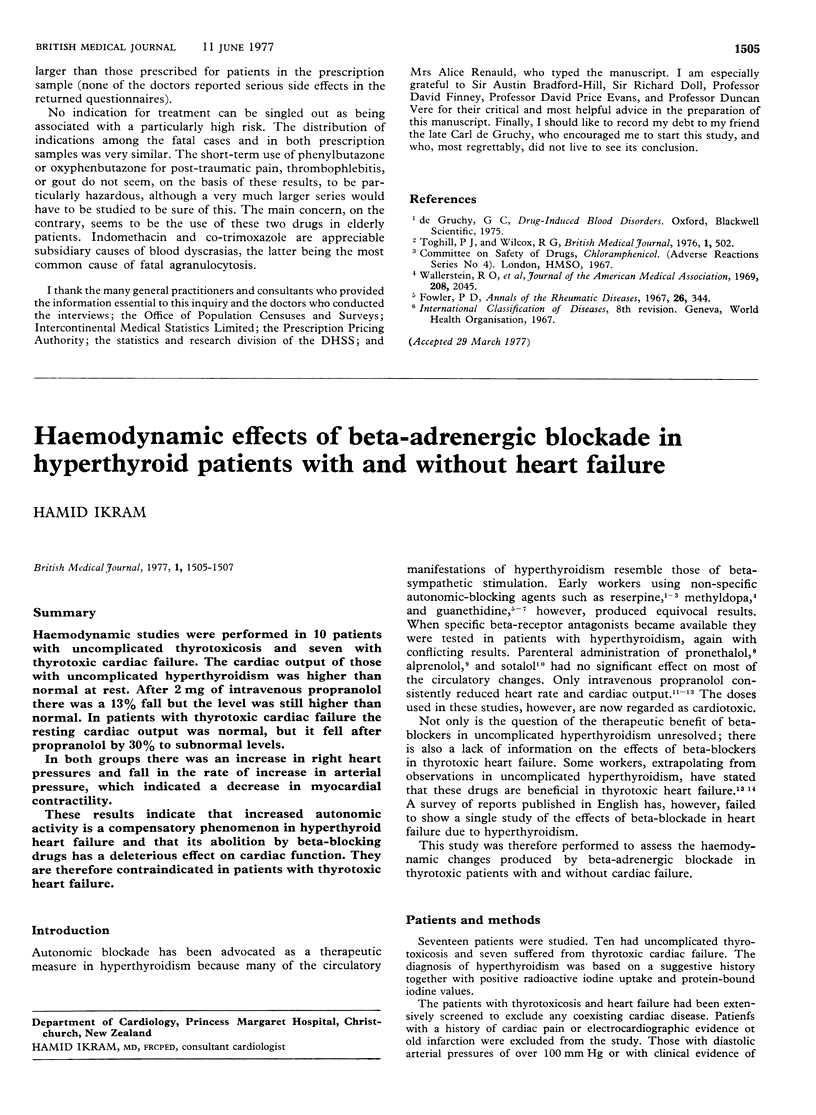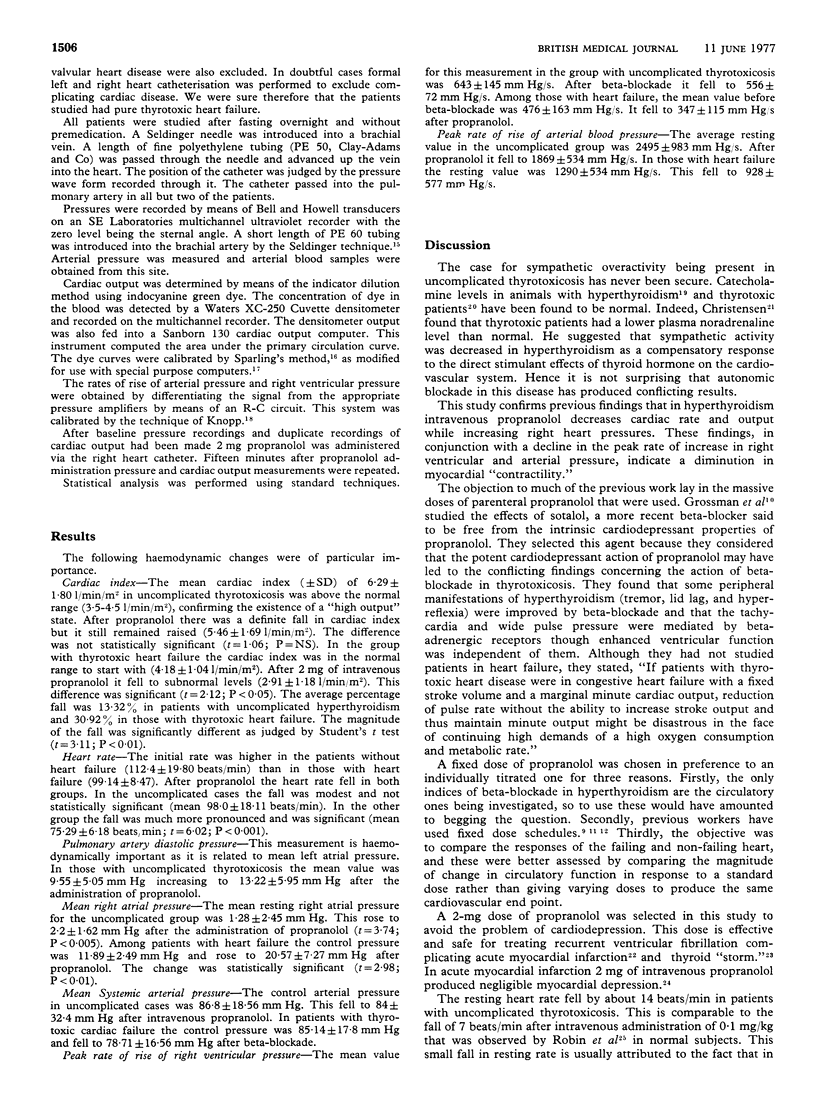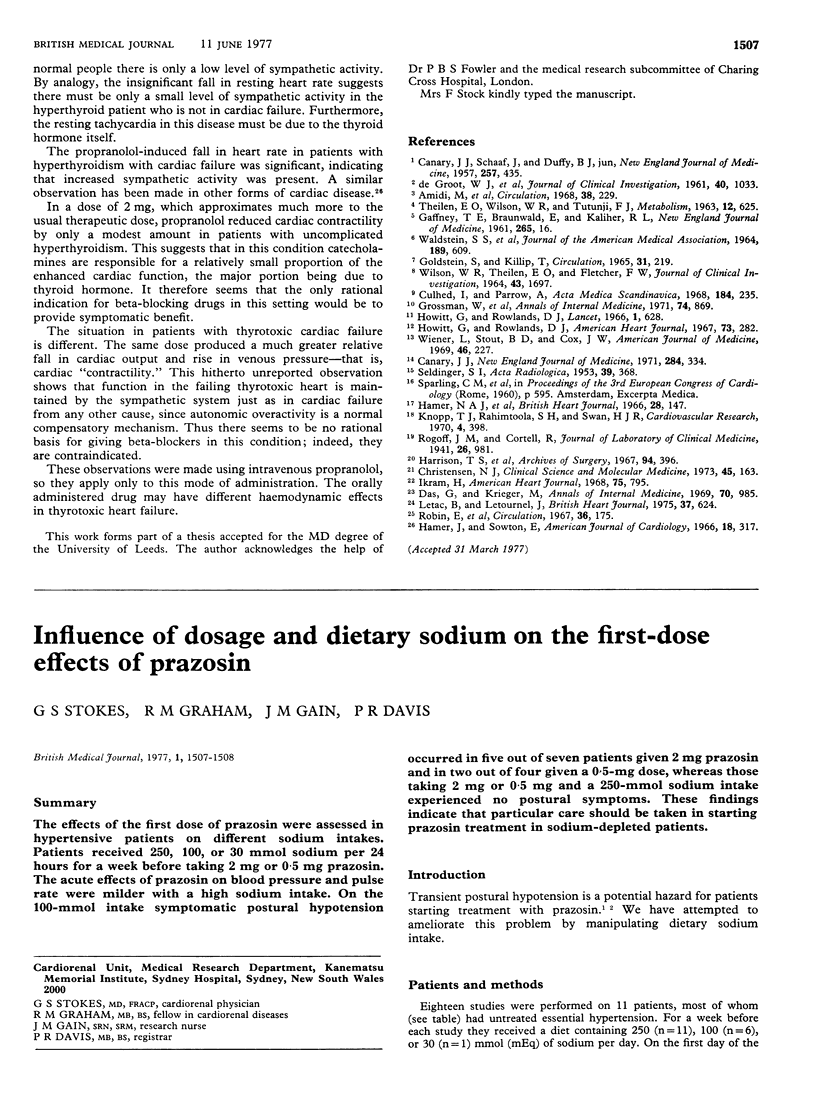Abstract
Haemodynamic studies were performed in 10 patients with uncomplicated thyrotoxicosis and seven with thyrotoxic cardiac failure. The cardiac output of those with uncomplicated hyperthyroidism was higher than normal at rest. After 2 mg of intravenous propranolol there was a 13% fall but the level was still higher than normal. In patients with thyrotoxic cardiac failure the resting cardiac output was normal, but it fell after propranolol by 30% to subnormal levels. In both groups there was an increase in right heart pressures and fall in the rate of increase in arterial pressure, which indicated a decrease in myocardial contractility. These results indicate that increased autonomic activity is a compensatory phenomenon in hyperthyroid heart failure and that its abolition by beta-blocking drugs has a deleterious effect on cardiac function. They are therefore contraindicated in patients with thyrotoxic heart failure.
Full text
PDF


Selected References
These references are in PubMed. This may not be the complete list of references from this article.
- Amidi M., Leon D. F., DeGroot W. J., Kroetz F. W., Leonard J. J. Effect of the thyroid state on myocardial contractility and ventricular ejection rate in man. Circulation. 1968 Aug;38(2):229–239. doi: 10.1161/01.cir.38.2.229. [DOI] [PubMed] [Google Scholar]
- CANARY J. J., SCHAAF M., DUFFY B. J., Jr, KYLE L. H. Effects of oral and intramuscular administration of reserpine in thyrotoxicosis. N Engl J Med. 1957 Sep 5;257(10):435–442. doi: 10.1056/NEJM195709052571001. [DOI] [PubMed] [Google Scholar]
- Cullhed I., Parrow A. Acute hemodynamic changes following beta-adrenergic blockade in hyperthyroidism. Acta Med Scand. 1968 Sep;184(3):235–239. doi: 10.1111/j.0954-6820.1968.tb02449.x. [DOI] [PubMed] [Google Scholar]
- Das G., Krieger M. Treatment of thyrotoxic storm with intravenous administration of propranolol. Ann Intern Med. 1969 May;70(5):985–988. doi: 10.7326/0003-4819-70-5-985. [DOI] [PubMed] [Google Scholar]
- GOLDSTEIN S., KILLIP T., 3rd CATECHOLAMINE DEPLETION IN THYROTOXICOSIS. EFFECT OF GUANETHIDINE ON CARDIOVASCULAR DYNAMICS. Circulation. 1965 Feb;31:219–227. doi: 10.1161/01.cir.31.2.219. [DOI] [PubMed] [Google Scholar]
- Grossman W., Robin N. I., Johnson L. W., Brooks H. L., Selenkow H. A., Dexter L. The enhanced myocardial contractility of thyrotoxicosis. Role of the beta adrenergic receptor. Ann Intern Med. 1971 Jun;74(6):869–874. doi: 10.7326/0003-4819-74-6-869. [DOI] [PubMed] [Google Scholar]
- Hamer J., Emanuel R., Norman J., Burgess M. Use of a computer in the calibration of dye dilution curves by a dynamic method. Br Heart J. 1966 Mar;28(2):147–151. doi: 10.1136/hrt.28.2.147. [DOI] [PMC free article] [PubMed] [Google Scholar]
- Harrison T. S., Siegel J. H., Wilson W. S., Weber W. J. Adrenergic reactivity in hyperthyroidism. Arch Surg. 1967 Mar;94(3):396–402. doi: 10.1001/archsurg.1967.01330090090023. [DOI] [PubMed] [Google Scholar]
- Howitt G., Rowlands D. J. Beta-sympathetic blockade in hyperthyroidism. Lancet. 1966 Mar 19;1(7438):628–631. doi: 10.1016/s0140-6736(66)90825-7. [DOI] [PubMed] [Google Scholar]
- Howitt G., Rowlands D. J. The heart in hyperthyroidism. Am Heart J. 1967 Feb;73(2):282–283. doi: 10.1016/0002-8703(67)90159-7. [DOI] [PubMed] [Google Scholar]
- Ikram H. Propranolol in persistent ventricular fibrillation complicating acute myocardial infarction. Am Heart J. 1968 Jun;75(6):795–798. doi: 10.1016/0002-8703(68)90040-9. [DOI] [PubMed] [Google Scholar]
- Knopp T. J., Rahimtoola S. H., Swan H. J. First derivative of ventricular pressure recorded by means of conventional cardiac catheters. Cardiovasc Res. 1970 Jul;4(3):398–404. doi: 10.1093/cvr/4.3.398. [DOI] [PubMed] [Google Scholar]
- Letac B., Letournel J. Evaluation of haemodynamic effects of intravenous propranolol at low dosage (1 and 2 mg) in acute myocardial infarction. Br Heart J. 1975 Jun;37(6):624–628. doi: 10.1136/hrt.37.6.624. [DOI] [PMC free article] [PubMed] [Google Scholar]
- Robin E., Cowan C., Puri P., Ganguly S., DeBoyrie E., Martinez M., Stock T., Bing R. J. A comparative study of nitroglycerin and propranolol. Circulation. 1967 Aug;36(2):175–186. doi: 10.1161/01.cir.36.2.175. [DOI] [PubMed] [Google Scholar]
- SELDINGER S. I. Catheter replacement of the needle in percutaneous arteriography; a new technique. Acta radiol. 1953 May;39(5):368–376. doi: 10.3109/00016925309136722. [DOI] [PubMed] [Google Scholar]
- Sowton E., Hamer J. Hemodynamic changes after beta adrenergic blockade. Am J Cardiol. 1966 Sep;18(3):317–320. doi: 10.1016/0002-9149(66)90048-8. [DOI] [PubMed] [Google Scholar]
- THEILEN E. O., WILSON W. R., TUTUNJI F. J. The acute hemodynamic effects of alpha-methyldopa in thyrotoxic patients and normal subjects. Metabolism. 1963 Jul;12:625–630. [PubMed] [Google Scholar]
- WALDSTEIN S. S., WEST G. H., Jr, LEE W. Y., BRONSKY D. GUANETHIDINE IN HYPERTHYROIDISM. JAMA. 1964 Aug 24;189:609–612. doi: 10.1001/jama.1964.03070080015003. [DOI] [PubMed] [Google Scholar]
- WILSON W. R., THEILEN E. O., FLETCHER F. W. PHARMACODYNAMIC EFFECTS OF BETA-ADRENERGIC RECEPTOR BLOCKADE IN PATIENTS WITH HYPERTHYROIDISM. J Clin Invest. 1964 Aug;43:1697–1703. doi: 10.1172/JCI105045. [DOI] [PMC free article] [PubMed] [Google Scholar]
- Wiener L., Stout B. D., Cox J. W. Influence of beta sympathetic blockade (propranolol) on the hemodynamics of hyperthyroidism. Am J Med. 1969 Feb;46(2):227–233. doi: 10.1016/0002-9343(69)90007-2. [DOI] [PubMed] [Google Scholar]


